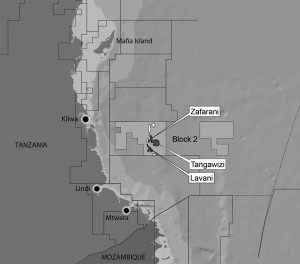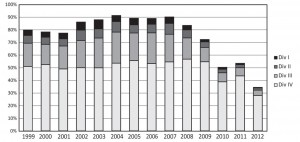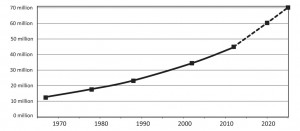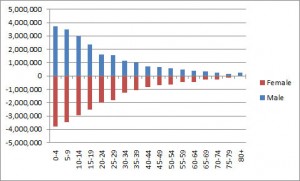by Hugh Wenban-Smith
This compilation of articles on Tanzania, culled from journals in the LSE library, covers January to June 2013. The abstracts are based on those published by the author(s).
“How does additional education affect willingness to work in rural remote areas in a low income context? An application to health workers in Tanzania” Kolstad, JR – Journal of Development Studies Vol 49(2).
A data set capturing stated preferences among freshly educated Tanzanian health workers with basic and more advanced education is applied to investigate how additional education affects willingness to work in rural areas. It turns out that those health workers with advanced education would have been more likely to prefer a job in a remote rural area had they not received this education. The finding is significant and substantial with several different specifications and robust with regard to omitted variables.
“Common counsel, common policy: Healthcare, missions and the rise of the ‘voluntary sector’ in colonial Tanzania” Jennings, M – Development and Change Vol 44(4).
Analysis of the voluntary sector in sub-Saharan Africa has tended to focus on the role of the NGO, and the types of relationships this institution establishes and maintains with donors, national governments and the communities with which they work. The voluntary sector in Africa is therefore usually defined through, and often treated as, synonymous with, the institution of the NGO. This article suggests that this view is too narrow in its gaze. The voluntary sector was not a creation of a post-colonial (and especially post-1970s) development crisis. It emerged from an evolving relationship between colonial era non-state (voluntary) actors and governments determined to demonstrate that they were meeting their commitments to the welfare of the Africans under their charge.
“Delivery care in Tanzania: A comparative analysis of use and preferences” van Rijsbergen, B & d’Exelle, B – World Development Vol 43. Maternal mortality remains high because of low use of skilled delivery care. While governments try to lower access barriers, little is known about women’s preferences. This study combines data from a survey and a choice experiment in Tanzania to compare women’s preferences with real choices of delivery care. We find that less empowered women and women who delivered their latest pregnancy outside a health facility find the technical quality of care less important, which indicates that their lower use of delivery care is partly induced by these preferences.
“Prostitution or Partnership? Wifestyles in Tanzanian artisanal gold-mining settlements” Bryceson, D F, Jonsson, J B & Verbrugge, H – Journal of Modern African Studies Vol 51(1).
Tanzania, along with several African countries, is experiencing a national mining boom, which has prompted hundreds of thousands of men and women to migrate to mineral-rich locations. At these sites, relationships between the sexes defy the sexual norms of the surrounding countryside to embrace new relational amalgams of polygamy, monogamy and promiscuity. This article challenges the assumption that female prostitution is widespread and using interview data with women migrants delineate six ‘wifestyles, sexual-cum-conjugal relationships between men and women that vary in the degree of sexual and material commitment. In contrast to bridewealth payments, which involved elders formalizing marriages through negotiations over reproductive access to women, sexual negotiations and relations in mining settlements involve men and women making liaisons and co-habitation arrangements directly between each other without third party intervention. Economic interdependence may evolve thereafter with the possibility of women, as well as men, offering material support to their sex partners.
“Remembering Nyerere: Political rhetoric and dissent in contemporary Tanzania” Becker, F – African Affairs Vol 112 (447). This article examines the changing uses of political rhetoric around the burial of Julius Nyerere in 1999. It argues that the ruling party uses rhetoric as a means of ‘soft power’ but also documents how this rhetoric, though geared towards legitimizing Nyerere’s successors, employed tropes that were rejected by some people and were used by others to critique leaders who were perceived to lack the selfless integrity attributed to Nyerere. The article compares funeral songs by a government-sponsored band, popular at the time of Nyerere’s death, with memories of Nyerere in rural areas in the early-to-mid-2000s. While the image of Nyerere in the funeral songs as a benign family patriarch writ large still persists, it co-exists with strongly divergent constructions of Nyerere as an authoritarian ruler or a self-seeking profiteer. Moreover, the ‘official’ benign Nyerere has been employed not only by government and party faithful, but also by striking workers, opposition politicians and critical newspapers as a measure of the shortcomings of his successors. The invocation of Nyerere as a paradigm of an endangered ideal of virtue in public office indicates widespread anxieties towards a state that often disappoints but occasionally delivers, in unpredictable turns, and the limits of the government’s ability to shut down dissent.
“Non-state actors and universal services in Tanzania and Lesotho: State building by alliance” D’Arcy, M – Journal of Modern African Studies Vol 51(2).
In recent years over half of all African states have re-introduced some form of universal basic service provision, though many more have done so in education when compared with health. This paper argues that while democratization has been important in generating pressure for reform, alliances with actors outside the state, such as donors and non-state service providers, have been the critical enabling factor allowing weak states to overcome their capacity constraints and respond. An inter-sector comparison of health and education policy in Tanzania shows how a difference in donor policy preferences between sectors – donors having converged behind the principle of universal primary education but not universal healthcare – has led to variation in alliance opportunities and hence policy outcomes.
“‘Let us swim in the pool of love’: Love letters and discourses of community composition in twentieth century Tanzania” Prichard, A C – Journal of African History Vol 54(1).
A series of love-letters exchanged between an African Anglican priest and a teacher in training before their marriage is used to investigate the relationship between the fashioning of the individual self, marriage and community at the dawn of Tanganyika’s independence. When seen through marriage’s historical position as an institution central to community composition, these letters illustrate how the family – and the intimate process of building families – could become an alternate site of national imagination. These two young lovers understood their marriage as an explicitly political act of community composition, and cast themselves as characters in the drama of national imagination. In negotiating their 20th century marriage, Rose and Gideon became political innovators, selecting, producing and testing the content and boundaries of the nation.
“Industrial policy and the political settlement in Tanzania: Aspects of continuity and change since independence” Gray, H – Review of African Political Economy Vol 40(136).
Tanzania’s experience of industrial policy since independence is explored through the concept of the political settlement. Higher growth in manufacturing since 1996 has been seen as a vindication of neoliberal policies of market liberalization. Yet, the neoliberal approach fails to take account of the important legacy of state-led industrialization under socialism and aspects of the political economy of the state in Tanzania that explain some of the longer-term constraints on industrialization. Critical aspects of Tanzania’s political settlement relate to state capital relations and the distribution of power between contending factions of intermediate classes within the state.






